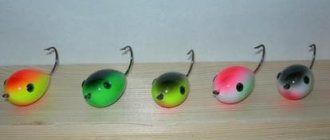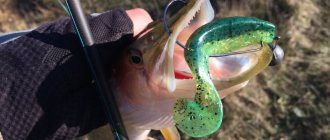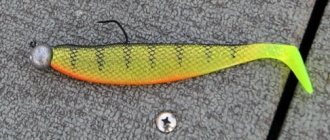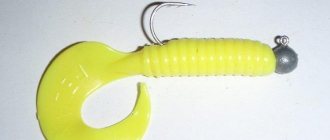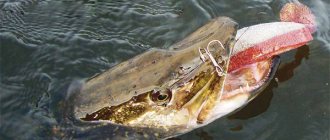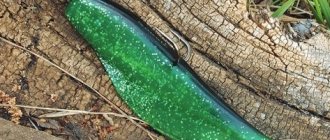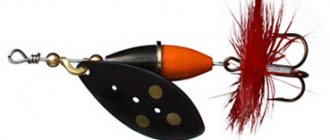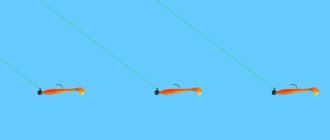What is a vibrotail
A vibrotail is a bait made of silicone that looks like a fry. In its rear part there is a tail blade located perpendicular to the body. During the wiring process, this blade oscillates, causing the entire bait to move.
In general, the vibrotail is currently among the leaders in popularity as bait for catching fish. The vibrotail is a fairly young invention; wobblers and spinners appeared much earlier. But despite its recent appearance, the vibrotail quickly conquered the fishing market.
Vibrotail has a number of advantages, firstly, it is not expensive, which allows you to buy a large quantity of this bait. There are a considerable number of different equipment that are used when fishing.
Also, this bait is suitable for any conditions, reservoirs - from small rivers to large lakes with deep areas and powerful currents. The vibrotail will attract pike at any time of the year, regardless of whether the pike is in an active or passive stage.
These advantages explain the success of the vibrotail among fishing enthusiasts. It is also important to choose the appropriate equipment and fishing technique.
Vibration tail tuning
Some fishing enthusiasts independently change the appearance of the bait. For example, they glue on 3D eyes, cut off the tail blades at the corners, and give them a new shape using a technical hair dryer.
Variety in colors will help you keep multi-colored baits in one package for several days. With periodic shaking, the process will speed up and the fish will acquire new colors. In order to make the baits less bright, they are placed in a sealed plastic bag with a small amount of water for 2-3 days. You can put silicone vibrating tails under the bright rays of the sun for a longer time.
So, a lot depends on the choice of bait. By following all the rules, you can make each fishing trip more and more successful and gain experience.
A few simple tips will help you save your catch.
It is better to use a spacious cage with a fine mesh. He should be in the shade. If the distance to the house is large, then the caught pike should be placed in a large container in layers and covered with fresh nettles. In hot weather, it is better to gut the fish. Article on the topic: Catching pike with girders
Which vibrotail is best for pike
If you are planning to catch pike using a vibrating tail, then you need to carefully consider the choice. The main criteria are the size of the bait, its shape, the material from which it is made, as well as color.
Photo: Vibrotail for pike
If the vibrating tail is made of soft silicone, then the movements of this bait will seem more natural to the pike, which will help to catch it. True, soft baits do not last long, but the catch from them completely compensates for this.
There are also vibrating tails made of “edible rubber”. Due to its composition, which includes attractants, mostly salt, the pike tastes this bait like regular food. In practice, pike try to eat such vibrating tails, which gives additional time to catch fish. The edible bait is especially suitable for catching pike when it is in its passive stage.
Vibrating tail size for pike
Pike are attracted by the leisurely swinging of the bait. This effect can be achieved using wide vibrating tails, which also have a large tail blade. Usually, when fishing for pike, vibrotails from 5 to 15 cm in length are used, but more often they are taken 8-10 cm long.
The best colors of vibrotails for pike
When fishing for pike, the color of the bait also plays an important role. In dirty water and on a day when there is no sun, it is best to use vibrator tails in bright colors, such as red. In clear weather and clear water, use faded colors.
In general, anglers divide bait colors into groups:
- naturalistic colors - silver, bronze and perch colors;
- provoking, acidic colors - green, yellow, orange, red;
Provocative colors irritate the pike, which causes it to become aggressive and further attack the bait, which has a good effect on the catch.
About
Choosing the size and shape of a vibrating tail for pike fishing
Length and shape
As mentioned above, the shape of a vibrating tail for pike resembles the body of a fish. Typically, the type of such bait is distinguished by two parameters - body and tail. Classically, the ripper has a rounded tail blade, but there are exceptions. Based on body shape, there are two types:
- "Long". A bait with an oblong and narrow body, reminiscent of bleak. This type of rig is usually used when fishing in the current. With the right approach, you can achieve a type of game where a bait of this type will imitate the sharp jerky movements of a fry that has strayed from the flock, which will certainly provoke the predator to attack.
- "Shad." The shape of such a vibrotail is distinguished by thickening in the middle part, which, as can be seen from the name itself, imitates prey with a herring-shaped body. This bait will be productive when fishing in holes and in deep water bodies. An example is a lake where whitefish, one of the favorite delicacies of northern pike, is found. In this case, a vibrating tail of this type is used, light in color with the addition of silver sparkles.
By the way, if a fisherman is hunting on a lake and accidentally discovers a promising river flowing into it, but he doesn’t have a bleak bait, then there is a way out, which is to make a long fish out of shad. To do this, you simply need to trim the wide part of the lake bait.
Also, when hunting for pike, you should remember that pike often attacks prey that is the same size as itself. Therefore, the choice of vibrating tail size depends solely on the mass of the expected trophies. If the reservoir is unfamiliar, then you can use rippers from 5 to 20 cm in length.
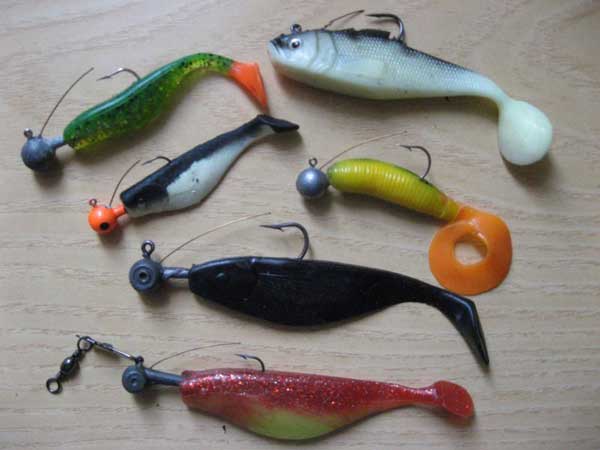
Ripper tail shape for pike fishing
The nature of the game when fishing for pike depends on the shape in which the tail of the vibrotail is made. In general, according to this criterion, baits can be divided into three types:
- Ripper with a small tail. Due to the low resistance to the oncoming water flow, the working part of the tail changes with high frequency, which imitates the rapid movement of a frightened fry.
- Vibrotail with a wide tail. Here, on the contrary, the large area of the tail creates strong resistance to water flows and the bait “plays” more measuredly, creating low and strong vibrations. This imitation reminds the pike of a large and clumsy prey.
- Lure without tail. It does not create vibrations, and the fishing technique resembles an ordinary tackle with a silicone fish.
When choosing a vibrating tail for pike, you must remember that various modifications of the tail in the form of slits or notches improve the dynamics of the bait. You should also pay attention to the quality of the product so that the tail part deviates from the center line in both directions with the same amplitude. To do this, you need to take the ripper by the head and shake it, visually observing its play. By turning the bait over and shaking the tail, you can determine the degree of softness of the material.
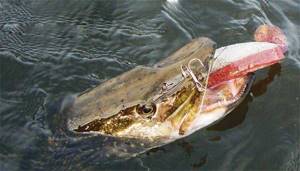
Choice of color and equipment option for a vibrating tail for pike
Depending on the depth, the nature of aquatic vegetation and the characteristics of the bottom soil, several main types of reservoirs can be distinguished where pike can live:
- Large deep lakes with a rich bottom topography or small bowl-shaped saucer lakes with an abundance of aquatic vegetation, and the exact opposite happens. The type of soil can also vary from rocky ridges to a silty bottom; the transparency of such reservoirs largely depends on this.
- Small ponds with heavily silted bottoms and a huge variety of coastal flora. The main source of food for the predator here is fish of the carp family, which it easily hunts, so in such reservoirs there is a chance to catch a large specimen, but with worse taste qualities than river or lake fish.
- Rivers and streams, which include a great variety of subtypes. These reservoirs can simultaneously combine areas with clear and muddy water, whirlpools, backwaters, barriers, various terrain, transform into small lakes, etc. Moreover, the rivers are home to a huge number of species of fish, and for some it is a spawning route. All this provides enormous opportunities for both beginners and experienced fishermen, since river pike is very careless and generally rarely pays attention to what object it is attacking, often becoming prey.
We recommend reading: Ten best wobblers with parameters for catching river perch
Of course, it will be quite difficult to describe all the nuances, so when visiting a reservoir you need to pay attention to everything. First of all, this is based on the transparency of the water; based on this criterion, you can choose the color. Here are some examples:
- The water is clear, the bottom is sandy with occasional rocky shelters. In this case, it is best to use a golden or pearlescent ripper with a black or blue stripe on the back. One color or another should be preferred depending on the light, blue is most effective in sunny weather, and black has an effect in rain.
- The water is clear, moderate depth, the presence of bottom vegetation. Such places are very fond of perch, which, in turn, is loved by pike and often accompanies it. Therefore, it makes sense to use baits that combine yellow, green, black and red shades. For example, a yellowish body with a black back, red tail and imitation red side fins. But just a red bait can also work.
- The water is muddy, the bottom is muddy, bottom vegetation is sparse, coastal vegetation is rich. Such places are most likely to be favored by various types of white fish, so the choice of color is obvious - any shades of silver, preferably interspersed with metallic sparkles.
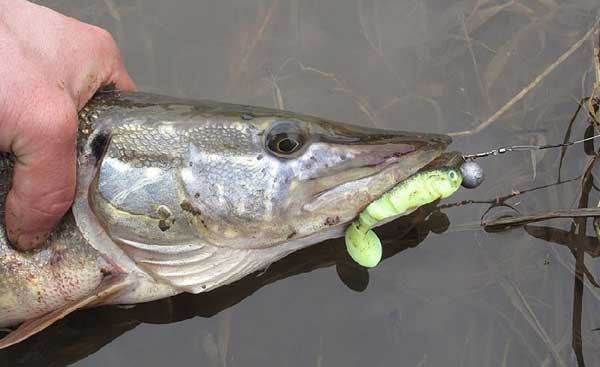
As you can see, even for three types of reservoirs, the arsenal of baits should be very diverse. And that's just about color. Therefore, when going fishing, study the fishing spot as much as possible. And remember that you shouldn’t give up fishing if you don’t bite the first time, you need to test baits of all possible colors. It also happens that a bite occurs with a very ambiguous choice.
After the angler has decided on the choice of color depending on the transparency of the water, it is necessary to pay attention to the presence of shelters for the predator. To do this, you need to walk along the shore and, as far as possible, examine whether there is driftwood or snags. Having collected this knowledge, we can summarize how to equip a vibrating tail. The options here are the same as for other silicone baits:
- The bottom is relatively clean, sandy or muddy. Here it is advisable to use a classic jig head. In this case, the equipment turns out to be rigid, since the hook is fixed in the sinker and directly in the body of the bait. Accordingly, it is necessary to remember the correct choice of hook length, which will ensure the desired game of the ripper. The main disadvantage is that it is not possible to change the bait without damaging it.
- The bottom is covered with snags, stones and other shelters. The advantage of such a place is that it is very promising, but you can only use rigs with non-snagging hooks here. For example, an offset hook with a “Cheburashka” type sinker. This method is good because the bait can be changed without damage, since it is attached to the head through a carabiner or a winding ring.
- The bottom is clean, mostly sandy, with sparse coastal vegetation. In such places, pike can be found in the summer; the predator goes out into shallow water to bask, not shying away from feasting on the fry swimming by. The use of loaded tackle in such places is unjustified, since the game will be unnatural, and the hooking due to the inertia of the bait and the small thickness of the water is very poor. Therefore, in such cases, the vibrotail is equipped with a double or triple hook without a sinker. Also, if you intend to hunt large fish, then such equipment is supplemented with a sinker and moved to a deeper place without snags. For example, this is a deep dump with a sandy bottom.
For unfamiliar water bodies, it is recommended to use flexible equipment, and when fishing in proven water bodies, it is recommended to use rigid equipment.
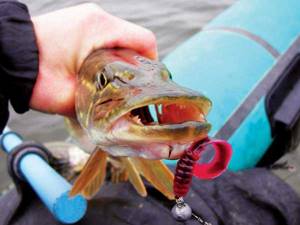
Equipment and installation of bait
When rigging, a different number of hooks is used: single, double, tee. Let's consider each of the methods in more detail.
Single hook rig
For example, when using a “G-head” rig, one hook is used. This method consists of a sinker and a single hook rigidly connected to it. For a successful bait, the sting is stuck into the central part of the head of the bait, then it is pulled with a stocking and the tip is brought out through the back of the back. When rigging, take your time; the bait should be clearly fixed and held securely. The “G-head” is relevant when the pike are in the active stage, since the vibrotail has most of the area for movement and plays in a sweeping manner. After falling, it sinks to the bottom slowly, and when biting, the pike does not feel the resistance of the weight of the sinker so much.
Double rigging
If you are using a double hook, the bait point will be the side of the bait. Slightly spreading the hooks of the double, we pierce the fish through the side with one hook and string the silicone along the entire fore-end. As a result, it will turn out that the vibrating tail will hang with its back between the two hooks of the double. Then, pressing the ring into the body of the bait towards its mouth, we thread the silicone through until the fastening ring comes out of the fish’s body. The installation is almost complete, all that remains is to straighten the nozzle to the length of the entire shank of the hook so that it receives its original geometric dimensions and is not subject to deformation.
Tee equipment
When equipped with a tee, you will need a tube made of metal or plastic, with a diameter of five millimeters, and a length of two centimeters is enough. The tube is needed to pierce the vibrotail through the side part.
How to attach a vibrating tail to a tee on a pike
As stated, pierce the vibrotail through the prepared tube - in the center of the side part. Next, in the hole made towards the mouth of the bait, inside the body, we thread a triple hook through the front with a fastening ring. Using the next hook, you will need to pierce the back through the same hole. It is important to bring out the end of the hook, keeping it parallel with the back of the silicone. The third hook does not need to be touched.
This equipment is best suited for reservoirs with clean water. Not suitable for areas with thick grass.
Vibrating tail installation
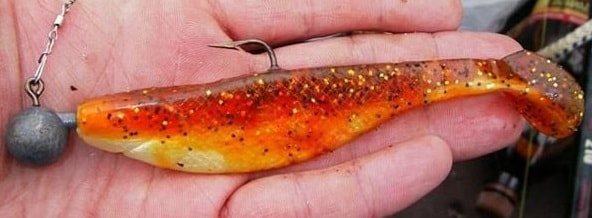
In order for the vibrotail not to fall off the hook and demonstrate a good game, it must be placed on the hook in the correct way. We advise you to prepare hooks and jig heads with bait in advance, and, of course, you will have a better chance of a good catch if you have several rigs with vibrating tails of different sizes and colors in your arsenal.
When using a jig head, the silicone vibrotail takes a position with its back up during the retrieve, and when using a hinged mount, the bait falls on its side.
Both positions are correct in their own way, since in the first case the bait looks more natural, and in the second it imitates a helpless, weak fish, which can also attract a hungry predator.
The hinged connection allows you to use both single hooks and doubles with tees without negative consequences for the action of the bait. Also, with an articulated joint, casting over long distances is better.
Related article: fishing with poppers
Vibrating tails for pike: Top 10 best
There are many models, but as a rule, you can always select ten that are the most catchy. Only fishing can show which vibrotail is the best, since a lot depends on the fishing conditions. ??so, lethal and best vibrotails for pike:
Manns Predator
Vibrating tails of this model have a large tail blade and notches on the back of the bait. As a rule, it is made from fairly soft silicone. Thanks to all this, the movements of this model seem natural to the pike, which is why it bites. Manns Predator is a leader in the lure market.
Manns Flipper
During wiring, the vibrating tails of this model: wag their tail, the vibrations have a high frequency, and also rotate from one side to the other. Does not lose its qualities even in strong currents.
Manns Billy
It has an oblong and narrow shape and a short tail. Suitable for different conditions and any type of wiring.
Manns Spirit
It has a distinctive feature in the form of a kind of keel at the bottom of the bait, thanks to which it plays with its whole body. This can lure pike, which is in a passive state.
Relax Copyto
Perhaps the oldest model of the vibrating tail itself has been on the market since the 90s, but is still in the top sales. This bait has a tall, narrow body and a large blade; this geometry ensures active play during the retrieve, which attracts pike. Many colors. A good vibrating tail, which many people use for pike.
Keitech Swing Impact
One of the edible baits, consisting of fairly soft silicone. Suitable for almost all equipment.
Bass Assassin Turbo Shads
The plus is the strength of silicone, which can withstand many pike attacks. It has a narrow shape and an extensive tail. Plays actively, even with light wiring.
Lunker City Salt Shaker
Like the previous model, it is made of durable silicone. It has an original body shape with a blunt anterior end. During wiring, the oscillation frequency is low, which can attract pike from considerable distances.
Lucky John Tioga
Another representative of edible bait. Smells and tastes like mackerel. The shape of the bait resembles a worm, but the blade located in the rear part provides it with active play.
Relax Jankes
A classic vibrotail with a body of medium height and a large tail blade. It attracts passive pike well and can help out a spinner in a situation where the fish does not react at all to other baits.
About
Installation
Despite the fact that the correct choice of bait already guarantees 70% of fishing success, in most cases the equipment is no less important. There are two main types of installation that need to be used, depending on the snarling of the pond and the number of thickets in it.
The first type is the simplest, when the hook sticks out. With such equipment, fish are caught more often, but the bait clings to snags no less often.

Another type of installation is intended for fishing in an overgrown pond. It uses not a regular hook, but an offset hook, which opens only when a fish bites.

Features of seasonal pike fishing with a vibrotail
The time of year also plays an important role in the pike catch.
in spring
At this time of year, pike leads an active “lifestyle”. Especially fishing in March brings a considerable catch. Pike can be caught not only at great depths, but they are also often found in shallow areas. Just before mid-spring, it is better to catch it in such areas, since there are a lot of small fish there, which the pike “comes” for.
In spring, fishing is good using edible vibrotails.
Summer and autumn
Summer and autumn are similar in terms of vibrotail fishing tactics. During this period, the pike is quite active.
When fishing with a vibrotail, stepped fishing is often used. In summer, a fishing method that is also common is dragging the sinker along the bottom; to do this, you need to evenly rotate the reel handle.
In July, due to the heat, the pike stays in areas overgrown with grass, and that’s where you need to look for it. Offset machines are suitable for such places.
Almost all autumn they use stepped wiring. Luminous vibrotails are often used.
From the ice in winter
At the beginning of winter, pike hunt in shallow waters. It is better to use edible silicone baits.
And if you fish from ice, then not at the beginning of winter. You need to wait until the ice becomes thick so as not to harm yourself by breaking the ice and falling into cold water. Well, by that time, the pike will have already entered a passive state due to frost and lack of light and oxygen. Therefore, edible baits and the use of provocative colors are suitable here.
At this time, pike lives in the depths.
As for the activity of playing with bait, there is varying success. It's worth experimenting with tempo.
Using large vibrotails when fishing for pike
If you intend to catch large predators, then it is advisable to use large-sized baits, which create more powerful disturbances and attract fish. The features of such rippers are their size of at least 20 cm, the weight of the tackle from 40 grams to 80 grams and the preferred modification - the “Shad” type.
Mounting a bait of this type on a jig head is carried out as follows:
- a jig head is taken and applied to the bait in order to mark the place where the hook exits the body;
- the place is marked by piercing it with a hook to a depth of approximately 1 mm;
- The hook of the head is inserted from the bow and is brought out into the marked hole.
You can also equip the bait with a double or tee. To do this you need:
- mount a crimp casing and a hook on a steel leash;
- pass the cambric through the eye of the hook, and thread the leash through the crimp cambric so that the hook is in the loop;
- Compress the cambric securely with pliers;
- Place the hook in the area of the bend of the caudal fin, and fix the leash through the loop connection on the body of the fish and the sinker.
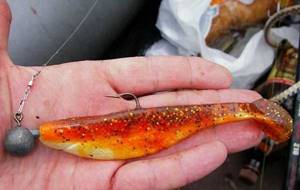
Video: Catching pike with a vibrotail (underwater filming)
The vibrotail is rightfully considered one of the best lures for pike fishing. It is distinguished by high catchability, versatility and affordable price. There are different rigs for fishing with this bait. Using them, you can fish in any conditions and still have good catches.
Views: 716
Similar articles:
- Catching pike with silicone. The best silicone lures for pike Silicone lures for pike are baits that are consistently popular...
- Fishing for pike by twitching. Top 5 best wobblers for twitching Twitching is a relatively new and quite effective fishing technique for…
- Catching pike with a jig. Top 10 best jig baits for pike One of the most effective and proven ways to catch pike is…
- Fishing for pike with a popper. Top 5 best poppers for pike Among the huge variety of lures for pike,…
Vibrating tail wiring
The technique of wiring vibrotails also involves variability. You can use the uniform wiring method, but it is not always effective. Pike perch are more often attracted by the effects of the jig head with bait hitting the bottom of the reservoir. In the case of a rocky bottom, a characteristic sound is produced, while when the tackle falls on a muddy bottom, a cloudy cloud is formed.
Important! On a rocky bottom, it is advisable to use tungsten weights; the thing is that tungsten rings loudly when it hits rocks, which very much attracts predatory fish due to the sound.
Many spinning athletes use baits on an offset hook with a swivel joint with tungsten Cheburashkas.
The jerking technique is good when fishing with vibrating tails. During a sharp jerk of the rod, the silicone bait quickly rises up, after which it smoothly falls again. To make it easier to record the moment the bait touches the bottom of the reservoir, it is recommended to use braided fishing line.
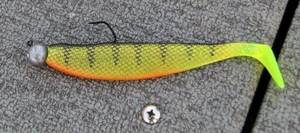
If you prefer a more relaxed fishing technique, you can, after casting the equipment, lift it by reeling in the fishing line. In this case, the bite is better recognized during the phase of lowering the bait to the bottom.
Another interesting method can be tested in practice when spinning fishing from a boat. Using a short spinning rod, the bait is lowered to the bottom, and then jerked with sharp movements of the hands. A pike perch can react to such a game of a vibrotail, loving to attack precisely when the bait falls to the bottom.
Rating of the 10 best twisters
Among the many models of twisters presented in fishing stores, there are those that have long been tested by fishermen and have proven themselves to be excellent.
Twister Reins Fat G-Tail Grub
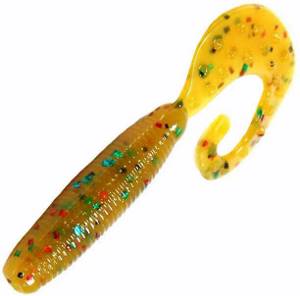
The body of the twister is solid, round in cross-section, with shallow perforations, reminiscent of a worm or larva. In the middle of the body of the twister there is a thickening in the center for easy installation on the hook. The silicone from which the bait is made has an increased density to increase the service life of the bait on the hook. The silicone contains added salt and an attractant that is resistant to leaching and weathering. The Reins Fat G Tail Grub comes in three lengths of two (5 cm), three (7.5 cm) and four inches (10 cm). A two-inch twister is good for catching bass of any size. The twister is three inches long and is the most versatile, suitable for catching perch, pike and pike perch. A four-inch twister should be used for catching large walleye and pike. There are more than two dozen twister color options. The Reins Fat G-Tail Grub twister is especially effective on even retrieving with playing along. You may be interested in: Perch fishing
Twister Relax Twister
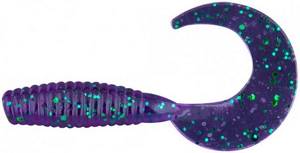
The Relax Twister has a classic twister appearance, with a ribbed body and a flat crescent-shaped tail. The Relax Twister has an active game and is made of strong and durable silicone. Twister has a wide range of sizes and a large number of colors. The Relax Twister is well suited for catching pike and zander on the river.
Twister Keitech Mad Wag
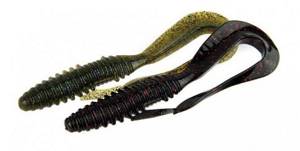
The Keitech Mad Wag twister is an excellent silicone bait designed for catching large pike, pike perch and catfish. The twister is 7 inches long, has a powerful ribbed body and a long triangular tail. The special tail design allows the bait to play even on the slowest retrieve. The ribs on the body of the twister not only visually increase the size of the bait, but also, when used with an offset hook, make the bait almost completely hook-free. The Keitech Mad Wag twister creates very powerful vibrations in the water that attract predators from a great distance. The twister is made of soft edible silicone, which contains a squid attractant. The twister can be mounted on a jig head, on an offset hook with a Cheburashka weight, and the twister can also be used as part of a variety of spaced rigs. The Keitech Mad Wag twister is produced in more than a dozen different colors, mostly dark shades.
Twister Mann`s Twister
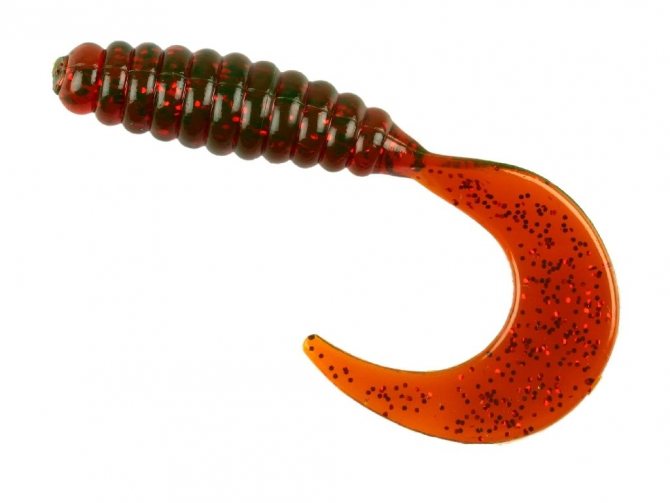
Mann's Twister has a classic twister shape: a ribbed body and a crescent-shaped ribbon tail. The bait is made of inedible silicone; the material retains its properties at low temperatures and is quite resistant to damage from the teeth of predators. Mann's Twister has an extremely mobile tail, which surprisingly resembles the movements of small fish. The bait is available in a variety of colors.
Twister Lucky John Pro Series Ballist
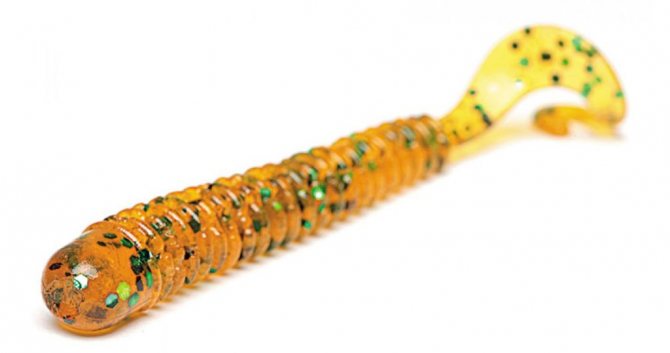
The Lucky John Pro Series Ballist twister is a hybrid between a twister and a silicone worm. The bait has an elongated ribbed worm-like body and a twister tail; its appearance can imitate different food items: fry, leech or worm. The Lucky John Pro Series Ballist twister is made of edible silicone with the addition of a shrimp-flavored attractant and comes in many color options. The twister can be used to catch pike perch, pike perch and pike perch.

The Lucky John Pro Series Ballist twister can be used with classic mounting options: on a jig head or on an eared weight, as well as for a split shot, lead leader, Texas and Carolina rigs. When fishing with the Lucky John Pro Series Ballist twister, you should use a slow, bottom retrieve, with light loading. You can diversify the fishing by dragging the bait along the bottom, taking short breaks of 10-15 seconds. Good results are shown by short stepwise wiring of one revolution of the coil, with pauses of 2-3 seconds.
Twister Pontoon 21 Hightailer
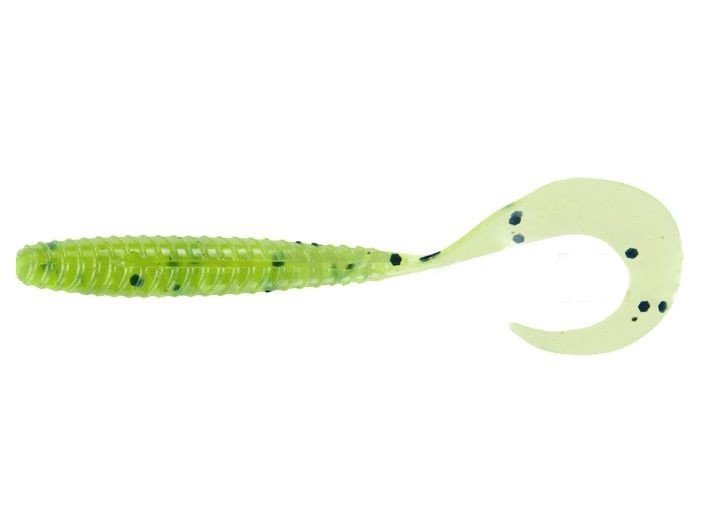
The Pontoon 21 Hightailer twister is made of soft edible silicone of the GUMEXIM brand with the addition of the SFT attractant. The twister has an elongated, slightly ribbed body and a long crescent-shaped tail. Inside the body of the Pontoon 21 Hightailer twister there is a special longitudinal channel, which makes it easier and more accurate to mount the twister on the hook, maintaining the correct centering and avoiding the bait falling over when retrieving. The size range includes twisters in 5 sizes, from 2 to 3.25 inches. The bait can be used when fishing both in still water and in the current; it plays well even on the slowest retrieve. The attractants included in the silicone twister additionally add to its attractiveness in the eyes of predators.
Twister Relax Turbo
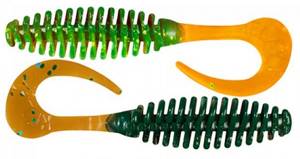
The Relax Turbo twister is produced by the American company Relax, well known to anglers. The twister is made of high-quality elastic silicone, which provides the bait with realistic movement at any fishing speed. The Relax Turbo twister is made using multi-level lamination technology, thanks to which different color layers are combined in the bait.
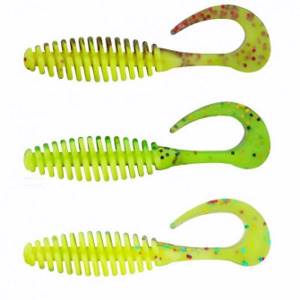
The Relax Turbo twister has positive buoyancy, which expands the fishing possibilities and provides a more interesting play of the bait when retrieving. Twister is produced in a wide range of colors.
Twister Crazy Fish Angry Spin
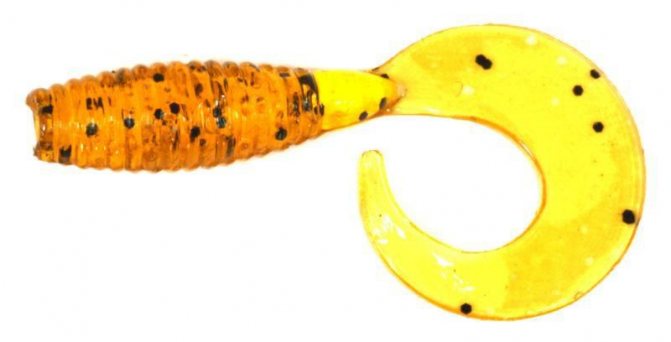
Twister Crazy Fish Angry Spin is a universal twister suitable for catching a wide variety of fish. The twister is made of soft silicone with the addition of two attractants and salt granules, which are embedded in the silicone, thanks to which the twister retains the aroma that attracts fish even after prolonged use. The tail of the Crazy Fish Angry Spin twister is very soft and flexible even with the slowest retrieve. The 1-inch long Crazy Fish Angry Spin is suitable for catching perch in tight ponds and can also be used for catching bream, rudd and other peaceful fish.
A twister so small that it can maintain its game even on a jig weighing 0.3 grams. The 2-inch long Crazy Fish Angry Spin twister is good for catching good perch, zander and medium-sized pike. Twister is available in a large number of catchy colors.
Twister YUM Walleye Grub
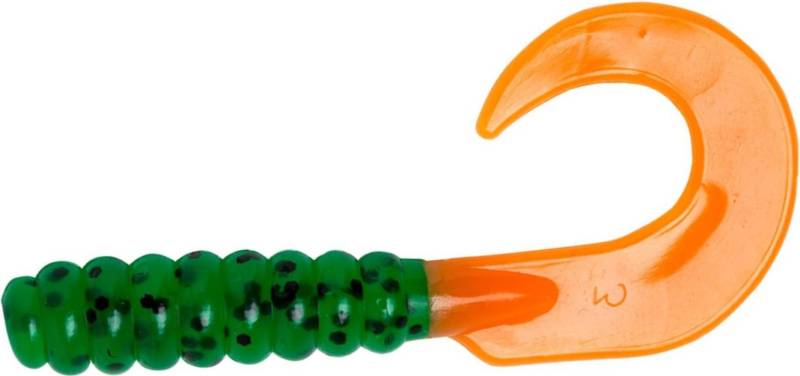
YUM Walleye Grub is a classic twister made from soft edible silicone with a strong and lasting anise aroma. The body of the YUM Walleye Grub twister has a heavily ribbed surface and a classic crescent-shaped tail. The twister tail plays well even with the slowest wiring. The bait is well suited for fishing in still water and on rivers. Twister is available in more than 20 color options. The twister can be used both in classic mounting options and for drop-shot and pull-out leash.
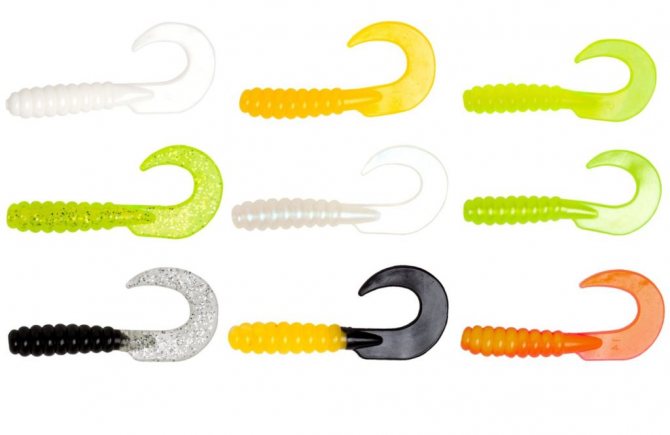
Twister Action Plastics 3FG
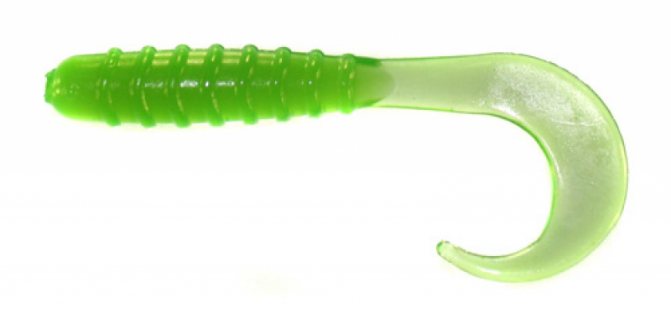
The Action Plastics 3FG twister is a classic twister with a ribbed body and a standard crescent tail. The silicone from which the twister is made is quite wear-resistant and can withstand several pike bites. Works well for most predators: perch, bass, pike and pike perch. The twister is produced in a variety of color variations, among which every angler will be able to choose the most suitable bait for specific fishing conditions. Twister has a good price-quality ratio. The Action Plastics 3FG twister can be used both in classic mounting options and for drop-shot and lead leash.

Twister and vibrotail: what are the differences and similarities
The fishing twister should not be confused with another silicone bait - the vibrotail, which has both some similarities and significant differences with the first.
Among the similarities are:
- The same material of manufacture - simple or edible silicone.
- In both types of baits, the working part is a movable tail.
- Similar range of colors.
Differences:
- Shape – the vibrotail, unlike the twister, imitates a small fish in shape and has a laterally flattened body.
- Location and nature of the game tail a - the plane of the vibrotail tail is located perpendicular to the axis of its body, it plays more intensely than that of a twister.
The vibrating tail works well for pike throughout the open water season, but it is better to use it when fishing in summer and late autumn.
Vibrating tails are most catchy in those reservoirs where there are a lot of fry - in such cases, the pike will be more likely to actively grab a bait that looks like a small fish rather than a twister.
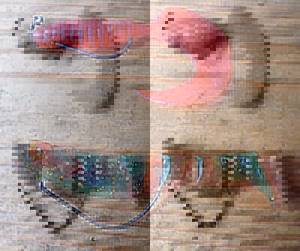
Above - twister, below - vibrotail
What is twister
A twister is a silicone bait in the form of a ribbed cylinder, on one side of which there is a crescent-shaped elastic tail.
It resembles an exotic fish with a lush tail. It is the tail that plays the main attracting role when the spotted predator is hunting. During the retrieving process, it actively wriggles, thereby causing an aggressive reaction from the pike and encouraging it to attack the rubber nozzle as if it were real prey.
Photo: What a fishing twister looks like
Twister characteristics:
- Consists of a body and a tail.
- The surface of the body can be smooth, grooved, or consisting of individual ring-shaped segments connected by a thin central part. When retrieving, they create additional vibrations and noises that attract predatory fish located at a great distance.
- They can be edible or inedible, with different flavors, colors, degrees of transparency and silicone modifications.
Fishing for pike with a twister is characterized by a simple technique for installing baits and a fairly simple wiring process, which is very important for novice fishermen.
Where and when to apply
A popular bait that is used by both beginners and professionals, it makes it possible to catch pike with a spinning rod in a variety of conditions:
- in small and large rivers;
- in shallow waters and at depth, as well as in places with differences in depth;
- in lakes and ponds;
- reservoirs.
It performs effectively both in still water and in currents. The main thing is to choose the right wiring and equipment.
In addition, fishing for pike with a twister is effective at any time of the year. Active hunting for the toothy predator begins in early spring and continues until the reservoirs are covered with ice. Although for fans of winter pike fishing, a twister is the main equipment in their arsenal.
What can you catch?
Twisters are universal baits that can attract not only pike, but also perch, pike perch, trout, catfish, burbot, asp and other freshwater predatory and peaceful fish. Fishing is most productive during times of high fish activity. Therefore, before fishing with silicone bait, it is advisable to find out at what periods each type of fish begins to feed most greedily.
Twister installation methods
There are several ways to install a twister, each of which has its own pros and cons.
Installing a twister on a jig head
Attaching a twister to a jig head is the most common way to mount this silicone bait. The most universal mounting method, can be used in a wide variety of fishing conditions. The jig head is a hook with a weight rigidly attached to it. The jig head can be in the shape of a bullet, fish head or boot, but the most common shape is a ball.
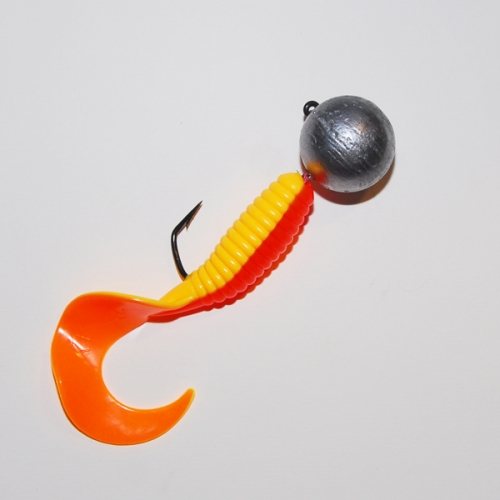
In order to attach a twister to the hook of a jig head, you must first compare their sizes with each other by attaching the hook to the body of the twister. The tip of the hook should come out on the last ribs of the twister, then it will work as it should.
Having remembered the place on the twister where the tip of the hook should come out, stick the hook into the end of the twister, carefully put the twister on it and bring it out in the place of the twister that you outlined at the very beginning. The hook, after installation, should not touch the tail of the twister.
You may be interested in: Favorite Professional spinning rod
Hinged mounting of a twister on an offset hook with a Cheburashka weight
Hinged mounting of a twister on a hook with a Cheburashka weight is one of the best ways to mount this bait. This mounting method gives the bait a maximum degree of freedom, which increases the chances of the bait being attacked by a predator. In addition, this installation method ensures maximum casting range.
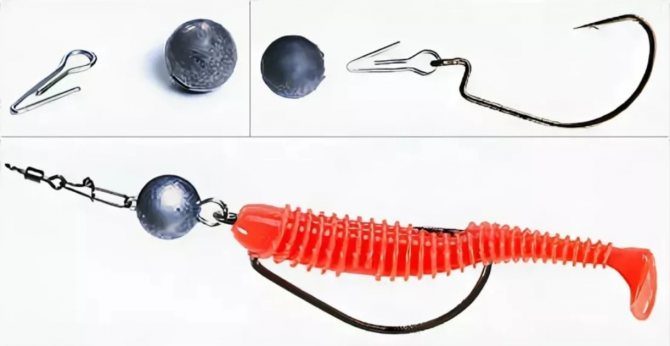
With a hinged installation, the twister can be mounted on a single, double or even triple hook. The hook is attached to the Cheburashka weight, either through a clasp that can be removed from it, or if the weight is not removable, then through a winding ring.
In order to place a twister on a hook, you first need to select a hook of the required length by attaching the twister to it and checking that the sizes match each other.
Insert the tip of the hook into the end of the twister, pass it through the body of the twister, and remove it from the body in a pre-designated place. After this, attach the hook to the weight.
When attaching a hook to a regular non-separable Cheburashka, you should either use two winding rings connected in series, or rotate the eye of the Cheburashka 90 degrees.
Installation of a twister on an offset hook in the form of a non-hook
Fishing with twisters is often carried out in difficult places: in areas with a rocky bottom, in snags, in reservoirs heavily overgrown with underwater vegetation. In such places, in order to avoid a large number of hooks and bait breaks, you should fish with a twister on an offset hook mounted in the form of a non-hooking hook. With this installation option, the tip of the hook is pressed to the body of the twister, and when a predator bites, it is released and digs into its mouth.
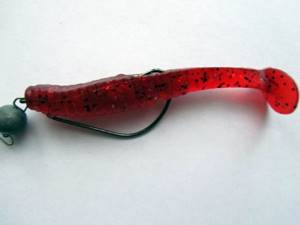
In order to mount the twister on an offset hook in the form of a non-hook, we pierce the end of the twister with the tip of the hook, insert it inside and bend it at a right angle. We stretch the twister to the shank of the hook. We try the twister on the hook and remember the location of the future puncture. We pierce the twister perpendicular to his body. We check the quality of installation of the twister, to do this we run our finger along its body; the finger should not cling to the hook, and with light pressure the body of the twister should sag.
Hinged mounting of a twister on a double with a Cheburashka load
Quite often, the twister is mounted on a double hook with a Cheburashka weight attached to it. There are two ways to mount a twister on a double. The simplest option is when the double is slightly spread apart, a twister is placed on one hook in the usual way, as on a single hook, and the other hook of the double is located outside the twister and acts as a pressure spring. This installation option is simple and allows you to quickly replace the twister on a double if necessary.
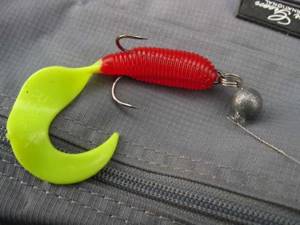
Another option for installing a twister is more complex. The hooks of the double are slightly moved apart, the tip of one hook pierces the twister approximately in the middle of the body of the twister, then the twister is pulled along the fore-end, to the eye of the double. When the eye of the double is in the body of the twister, push it forward of the body of the twister until the eye comes out at the end of the twister. With this installation method, you should use a twister made of durable and elastic silicone, otherwise the twister will break during installation.
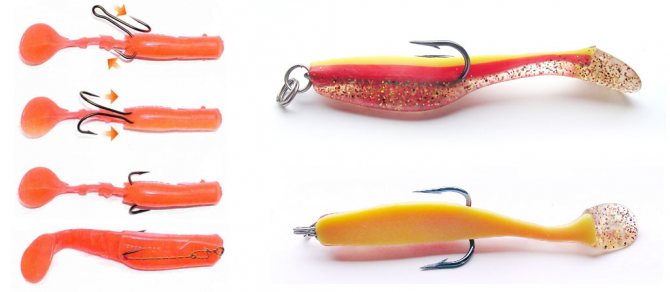
Exploded snap-ins

Recently, a wide variety of spaced-out equipment has become increasingly popular among spinning fishermen. With spaced rigs, the silicone bait attached to the hook and weight are spaced apart from each other. With this installation option, the silicone bait receives more freedom of movement, and the angler can perform a wide variety of wiring. Spaced spinning rigs include: lead leader, drop shot, split shot, Texas and Carolina rigs. With all these and other spaced-apart equipment, you can and should use a twister.
